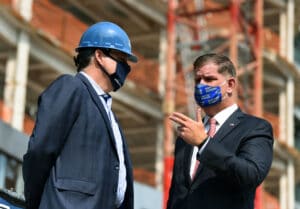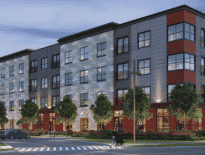
Boston Mayor Marty Walsh, right, speaks with MassMutual CEO Roger Crandall at a topping-off ceremony for the company’s new offices at 10 Fan Pier in the city’s Seaport District. Photo by Isabel Leon | Boston Mayor’s Office
Mayor Marty Walsh turned out to be a short-timer, at least by the standards of Boston politics.
A former union leader and Dorchester boy who got its start as a construction worker, Walsh is leaving Boston for Washington, D.C. after barely clocking seven years, the shortest mayoral tenure since James Michael Curley spent five months in the slammer in his last term in office in the late 1940s.
Walsh’s time in office was brief compared to the city’s last three mayors, Thomas M. Menino, Ray Flynn and Kevin White, who served for 20, 11 and 16 years, respectively.
Reasonable and amiable, Walsh never dominated the city’s political and development scenes like the mercurial and never-to-be-crossed Menino or White, larger than life but tragically flawed.
Yet Walsh will leave as big an impact on Boston’s skyline and cityscape as any of his predecessors.
And Walsh, a former top labor leader and state representative, did it not by micromanaging development in Boston, but by getting out of the way and letting the boom times roll.
No Fifth-Floor Dictator
Walsh will never be considered a visionary like White was at times, having overseen the redevelopment of the Faneuil Hall and the construction of the iconic Hancock Tower.
But then again, Walsh isn’t leaving office under the cloud of a federal investigation into widespread corruption and shakedowns in city government like White was when he called it quits in 1983.
Walsh’s immediate predecessor, Menino, broke the record for longevity in office and was effectively developer-in-chief, building a massive new convention center and getting the redevelopment of the Seaport off the ground.
Walsh never amassed the kind of unchallengeable political power that Menino wielded as he ran Boston like a dictatorship, freezing out those suspected of even the slightest disloyalty or rumored slight – especially developers, who could suddenly find proposed projects all but shut down by the City Hall bureaucracy.
Nor did he play architect like Menino did, demanding developers put a silly, baby bottle cap on 111 Huntington in the name of ornamentation.
Instead, Walsh’s more hands-off approach – and the much thicker political skin needed to go with it – was a key ingredient in taking Boston’s building boom to new and record heights over the past few years.
Walsh appointed capable people to top posts, like Brian Golden at the Boston Planning & Development Agency and Sheila Dillion as housing chief and director of the Department of Neighborhood Development, and then let them not only do their jobs, but speak to the press freely as well.
That hasn’t always been the case. When past agency chiefs spoke to reporters, they were forced to offer ridiculous denials of obvious trends or facts, like insisting – in the middle of a recession – that a major waterfront project championed by the mayor was about to miraculously break ground any day.
By stepping back and not taking everything personally, Walsh let a great city flourish, with developers free to propose, plan, build and tout their projects without fear of stifling City Hall intrigue.
An Approach That Got Results
The numbers tell the story, with Boston during the Walsh years having given a green light to 77 million square feet of new real estate development, including plans for a new neighborhood at the old Suffolk Downs racetrack.
That’s the equivalent of 64 new Prudential towers, as Banker & Tradesman has previously noted, and it includes the approval by city officials of 40,000 new apartments, condos and homes as well.
That said, Walsh stepped forward forcefully at key moments when mayoral leadership was needed.
He became the first big city mayor in the country to shut down construction last spring as the first wave of the coronavirus hit.
It was no easy decision.
The move sparked fears among contractors and developers that the city’s long-running building boom might be derailed, while construction workers feared the sudden loss of their livelihoods.
Walsh’s decision gave city officials enough time to come up with a system of safety rules and requirements for construction sites, as well as a permitting process to ensure contractors were complying.
The building boom, as is obvious now, did not collapse, while the measures Walsh insisted on certainly helped combat the spread of COVID-19 at construction sites across the city and beyond.
Last month, Boston scored another first under Walsh’s leadership.
The BPDA said it would move forward with plans pushed by District 1 City Councilor Lydia Edwards and District 8 Councilor Kenzie Bok to begin using Obama-era, federal anti-discrimination rules when reviewing major new apartment and condo projects.

Scott Van Voorhis
For a mayor committed to development and the well-paying union jobs new construction creates, it was a significant move.
The new rules promise to add another layer of regulatory review atop the city’s already comprehensive permitting process.
But then again, this mayor has never been afraid to do the right thing.
And that, along with the city’s extraordinary building boom, will be a key part of how Marty Walsh’s relatively short, but eventful, tenure as Boston’s mayor will be remembered.
Scott Van Voorhis is Banker & Tradesman’s columnist; opinions expressed are his own. He may be reached at sbvanvoorhis@hotmail.com.




 |
| 
